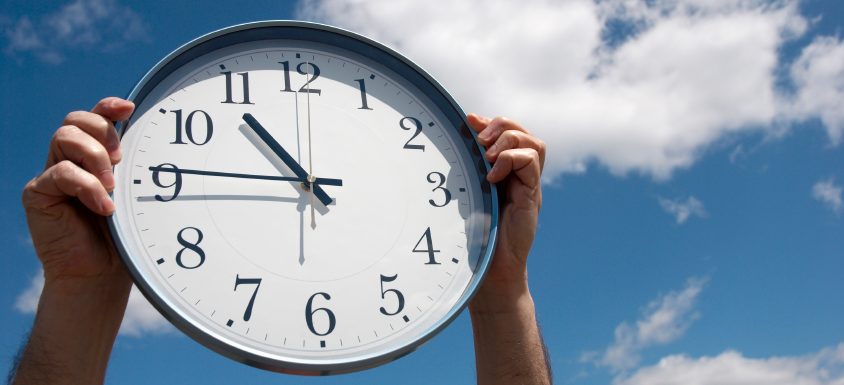![]()
I like my oatmeal smooth and creamy, but that takes more time. I would rather not have oatmeal at all than have it thick and lumpy, which is what happens when you cook it too quickly. Why do I feel I don’t have enough time to make creamy oatmeal?
Time is a funny thing. We sing about it, wanting to save it in a bottle and wondering if anyone really cares. It’s part of our daily lexicon. There’s no time like the present. That was time well spent.
Most often, we want to know, “Where does time go?” As you gather around the watercooler after Labor Day, you’ll likely bemoan the passing of summer. “It went too fast,” you’ll say. “It feels like it just began.” (If you feel that way because you neglected to take a vacation, you might be a work martyr.)
Of course, maybe we’re just showing our age. When we were young, we kicked the back of the car seat, asking, “Are we there yet?” Holidays and birthdays never came around fast enough, and we couldn’t wait to drive. Millennials may be crossing that last item off their to-do list since fewer of them are driving.
I did get my license, after multiple tries—perhaps I was in too much of a hurry to learn what I needed to know. And I haven’t stopped rushing. There never seems to be enough time in a day or a week, and the years are flying by.
There is some interesting science about the perception of time, and how it changes as we age. For instance:
- In 1897, French philosopher Paul Janet put forth what is sometimes called the “proportional theory.” Janet believed we perceive time by comparing it to our life span. When we are a year old, one year is 100 percent of our life. At age 18, one year is 5.56 percent of our life. After age 30, the proportion begins to level off. In short, as this graphic by Austrian designer Maximilian Kiener illustrates, the more time we’ve lived, the shorter each year feels. (It’s well worth the time to scroll through this. As Kiener writes, “In the end, it will be over faster than you thought or hoped it would be.”)
- Attention, memory, and emotion also influence our perception of time. In 1890, psychologist William James wrote that time seems to speed up as we age because there are fewer and fewer memorable events in adulthood, compared to years when we experience so many “firsts” (think first day of school, first date, first kiss). “The more detailed the memory, the longer the moment seems to last,” neuroscientist David Eagleman says. “The more familiar the world becomes, the less information your brain writes down, and the more quickly time seems to pass.”
- Of all the emotions that influence our perception of time, stress ranks up at the top. The more pressure we are under, the more likely we are to feel that time is going by in a flash. And technology, which we might believe gives us more time, may actually be stealing it away. Psychologist Aoife McLoughlin has found evidence that our smartphones and computers help us work faster, but also make us feel pressured to do more.
I understand that pressure. A few weeks back, I was skimming through emails—little time to read—when one of them stopped me cold. It was from Chris Brogan, New York Times bestselling author and CEO of Owner Media Group. Chris and Owner Media Group co-founder and President Rob Hatch help grow businesses, but their approach is very personal. Well-rounded (and well-rested) leaders succeed. So here was Chris telling me that to go faster and get more done, I had to slow down. He quoted something that the U.S. Navy SEALs teach—“Slow is smooth. Smooth is fast.”
Slow is smooth. Smooth is fast. Simple and yet profound. How many times are we rushing to get to work and spill our coffee, making us later still? When I try to write without making an outline first, it takes me longer to finish. While watching the Rio Olympics, I was impressed by the grace of the swimmers. Those who made it to the line first were slow and steady. The more you splash and thrash, the slower you go.
Slow is smooth. Smooth is fast. So how do we learn to slow down? I’m still working on that. I know many who swear by mindfulness meditation, and the science behind it is strong. Back at Owner Media Group, Chris and Rob teach a series of JUMPSTART courses, including a 20-minute plan that helps you begin and end each day by focusing on your priorities. Building on the idea that the more new things we have to process, the slower time feels, Jessica Stillman makes the seemingly counterintuitive suggestion that we seek out new and different experiences.
I’m not certain if any of these ideas makes sense for me, or whether they will resonate with you. For now, it’s enough for me to keep repeating, “Slow is smooth. Smooth is fast.” Maybe I’m beginning to learn to meditate without even trying. How do you slow down and savor time?
Susan Milstrey Wells is part of the GovLoop Featured Blogger program, where we feature blog posts by government voices from all across the country (and world!). To see more Featured Blogger posts, click here.





Leave a Reply
You must be logged in to post a comment.